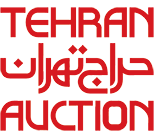The works of Ziapour are considered a major part of what can be called Iranian pure Modernism. Colorful geometric forms in this work are, indeed, the first Cubist interpretation of an Iranian painter of form and its structural quality. In other words, this series of Zaipour’s works introduced the Iranian art community to European pure abstraction. Although the application of the term “Cubist painting” may not represent a thorough interpretation of the work, we must admit that Jalil Ziapour introduced for the first time the ultimate effect of the Cubist concepts of form into Iranian visual arts. Cubic forms that turn the present painting into a grid are the products of a perspective that defy naturalist representation of the subject to rebel against the visual traditions of the time. Armed with the teachings of École Nationale Supérieure des Beaux-Arts in Paris, Ziapour brought in his vision to strike a balance between color and form. In fact, he attached equal significance to juxtaposition of blue, green and red colors as well as to geometric forms. Thus a spectrum of warm colors gradually changes to cold colors to strike a balance between color and form in the work. Nevertheless, a hot, throbbing center on the right draws the attention of the viewers. Ziapour had extensively researched and possessed a deep understanding of Iranian folk culture. This is evident in different periods of his career, especially in his figurative paintings. An attempt to present an Iranian version of imported Modernism is often seen in his work as well. The indigenous outlook of the artist can be easily detected in this painting; influences of Iranian old architecture, decorative grids as well as applied traditional settings are felt in the work.
The significance of this particular work needs to be sought both in its aesthetic qualities and the personality of Jalil Ziapour as well as developments he initiated into the history of Iranian art of this period. Being among the first group of graduates of the Faculty of Fine Arts, University of Tehran, Jalil Ziapour learned about Cubism during his studies in Europe. He considered the style a significant method in bringing innovation to Iranian painting and creating a fresh path in Iranian art. The importance of Ziapour in the history of Iranian modern art is not limited to his works. On his return to Iran in 1949, Ziapour and his associates established an art society known as “Khorous the Fighting Cock”, an avant-garde league that opended up new horizons, especially in literature, music, and painting. At the same time, they began publishing a magazine with the same title. He described the mission of “Khorous the Fighting Cock” as a campaign against blind regression and traditionalism, choosing as a slogan the poetry of Farokhi Sistani:
Turned into an old myth the story of Alexander
So bring in a fresh subject, all the more joyous
Delivering lectures, compiling articles, and organizing exhibitions that occasionally provoked stiff opposition by the media, traditional artists, and authorities, Ziapour strived to promote and consolidate modern art in Iran.
Throughout his artistic career as a painter, Ziapour had always been known as an avant-garde leader, promoting modern art and initiating criticism in Iran. He had to battle on four different fronts; imitators of the past styles, unoriginal modernists returning to Iran, regressive communists, and followers of European old practices. He strived to rely on the capacities of indigenous culture to safeguard Iranian identity yet communicating in a universal language in order to exalt his Persian culture.

